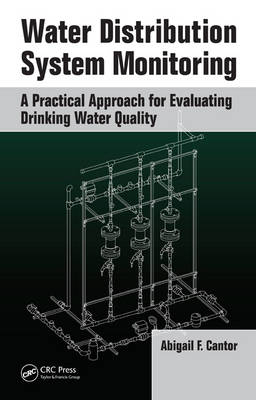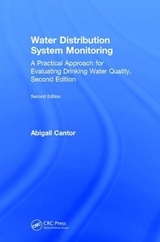
Water Distribution System Monitoring
A Practical Approach for Evaluating Drinking Water Quality
Seiten
2009
Crc Press Inc (Verlag)
978-1-4398-0052-2 (ISBN)
Crc Press Inc (Verlag)
978-1-4398-0052-2 (ISBN)
- Titel erscheint in neuer Auflage
- Artikel merken
Zu diesem Artikel existiert eine Nachauflage
A typical water distribution system is complex and chaotic with varying piping configurations, water flows, chemical reactions, and microbiological activity. This book provides a practical approach and open-source technology for proactive water quality management. It describes a method for routinely monitoring the water distribution system.
A typical water distribution system is complex and chaotic with varying piping configurations, water flows, chemical reactions, and microbiological activity. It is therefore no surprise that monitoring water quality can be a daunting task, not to mention dealing with the devastating and costly effects of:
Noncompliance with the Lead and Copper Rule
Pinhole leaks in water service lines and private plumbing
Vulnerability to microorganisms in the water distribution system
Unwanted side effects from treatment chemicals
Mistakes in treatment chemicals and dosage amounts
These common water quality issues can be avoided by routinely monitoring key water quality parameters in the distribution system in a controlled and standardized manner. While proactive monitoring costs money, having water quality problems is even more costly.
Water Distribution System Monitoring: A Practical Approach for Evaluating Drinking Water Quality provides a practical step-by-step approach and open-source technology for proactive water quality management. It describes a method for routinely monitoring the water distribution system by:
Assembling a standardized monitoring station
Planning a monitoring strategy, and
Interpreting and using the water quality data
Deliver safe and economical drinking water to your customers. Why wait three years to find out if the water system is in compliance with the Lead and Copper Rule? Why guess which corrosion control chemical is the right one? Why guess how much disinfection is needed in the water distribution system?
Optimize your chemical usage, minimize your operational expenses, and confirm that the water is safe. Laying out a path to quality control and process improvement, this book provides the tools for well-defined and measurable control of water quality.
A typical water distribution system is complex and chaotic with varying piping configurations, water flows, chemical reactions, and microbiological activity. It is therefore no surprise that monitoring water quality can be a daunting task, not to mention dealing with the devastating and costly effects of:
Noncompliance with the Lead and Copper Rule
Pinhole leaks in water service lines and private plumbing
Vulnerability to microorganisms in the water distribution system
Unwanted side effects from treatment chemicals
Mistakes in treatment chemicals and dosage amounts
These common water quality issues can be avoided by routinely monitoring key water quality parameters in the distribution system in a controlled and standardized manner. While proactive monitoring costs money, having water quality problems is even more costly.
Water Distribution System Monitoring: A Practical Approach for Evaluating Drinking Water Quality provides a practical step-by-step approach and open-source technology for proactive water quality management. It describes a method for routinely monitoring the water distribution system by:
Assembling a standardized monitoring station
Planning a monitoring strategy, and
Interpreting and using the water quality data
Deliver safe and economical drinking water to your customers. Why wait three years to find out if the water system is in compliance with the Lead and Copper Rule? Why guess which corrosion control chemical is the right one? Why guess how much disinfection is needed in the water distribution system?
Optimize your chemical usage, minimize your operational expenses, and confirm that the water is safe. Laying out a path to quality control and process improvement, this book provides the tools for well-defined and measurable control of water quality.
Process Research Solutions, Madison, Wisconsin, USA
Concepts
Strategic Planning
Initial and Routine Monitoring
Case Studies
Economics
Afterword
Appendix A Strategic Planning Worksheets
Appendix B Water Quality Parameters
Appendix C Metal Plate Film Analyses
Appendix D Process Research Solutions Monitoring Station
Appendix E Data Management and Analysis
References
Index
| Erscheint lt. Verlag | 12.3.2009 |
|---|---|
| Zusatzinfo | Less than 10; 105 Tables, black and white; 54 Illustrations, black and white |
| Verlagsort | Bosa Roca |
| Sprache | englisch |
| Maße | 156 x 235 mm |
| Gewicht | 512 g |
| Themenwelt | Technik ► Umwelttechnik / Biotechnologie |
| ISBN-10 | 1-4398-0052-9 / 1439800529 |
| ISBN-13 | 978-1-4398-0052-2 / 9781439800522 |
| Zustand | Neuware |
| Informationen gemäß Produktsicherheitsverordnung (GPSR) | |
| Haben Sie eine Frage zum Produkt? |
Mehr entdecken
aus dem Bereich
aus dem Bereich
Kommentar der DIN 15905-5, LärmVibrationsArbSchV und …
Buch | Softcover (2023)
DIN Media (Verlag)
58,00 €
Buch | Softcover (2023)
DIN Media (Verlag)
75,40 €
Buch | Softcover (2024)
Pearson Education Limited (Verlag)
75,95 €



